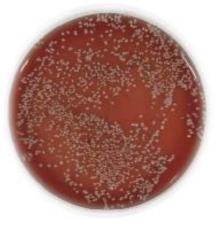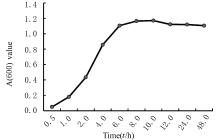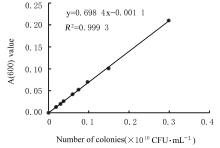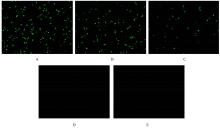| 1 |
CARVALHO M F, GILL D. Rotavirus vaccine efficacy: current status and areas for improvement[J]. Hum Vaccin Immunother, 2019, 15(6): 1237-1250.
|
| 2 |
CÁRCAMO-CALVO R, MUÑOZ C, BUESA J,et al. The rotavirus vaccine landscape, an update[J]. Pathogens, 2021, 10(5): 520.
|
| 3 |
KIM A H, HOGARTY M P, HARRIS V C, et al. The complex interactions between rotavirus and the gut microbiota[J]. Front Cell Infect Microbiol, 2020, 10: 586751.
|
| 4 |
GOZALBO-ROVIRA R, RUBIO-DEL-CAMPO A, SANTISO-BELLÓN C, et al. Interaction of intestinal bacteria with human rotavirus during infection in children[J]. Int J Mol Sci, 2021, 22(3): 1010.
|
| 5 |
SHI Z D, ZOU J, ZHANG Z, et al. Segmented filamentous bacteria prevent and cure rotavirus infection[J]. Cell, 2019, 179(3): 644-658.e13.
|
| 6 |
VLASOVA A N, KANDASAMY S, CHATTHA K S,et al. Comparison of probiotic lactobacilli and bifidobacteria effects, immune responses and rotavirus vaccines and infection in different host species[J]. Vet Immunol Immunopathol, 2016, 172: 72-84.
|
| 7 |
AHMADI E, ALIZADEH-NAVAEI R, REZAI M S. Efficacy of probiotic use in acute rotavirus diarrhea in children: a systematic review and meta-analysis[J]. Caspian J Intern Med, 2015, 6(4): 187-195.
|
| 8 |
ZHAO W, YU M L, TAO X L, et al. Analysis of the intestinal microbial community altered during rotavirus infection in suckling mice[J]. Virol J, 2021, 18(1): 254.
|
| 9 |
FRANZ C M, HUCH M, ABRIOUEL H, et al. Enterococci as probiotics and their implications in food safety[J]. Int J Food Microbiol, 2011,151(2): 125-140.
|
| 10 |
HOLZAPFEL W, ARINI A, AESCHBACHER M,et al. Enterococcus faecium SF68 as a model for efficacy and safety evaluation of pharmaceutical probiotics[J]. Benef Microbes, 2018, 9(3): 375-388.
|
| 11 |
焦月华. 基因组学分析粪肠球菌益生功能及增殖调控研究[D]. 哈尔滨: 哈尔滨工业大学, 2016.
|
| 12 |
MA C F, WU X K, NAWAZ M, et al. Molecular characterization of fecal microbiota in patients with viral diarrhea[J]. Curr Microbiol, 2011, 63(3): 259-266.
|
| 13 |
YANG M L, YANG Y, HE Q N, et al. Intestinal microbiota-A promising target for antiviral therapy?[J]. Front Immunol, 2021, 12: 676232.
|
| 14 |
CRAWFORD S E, RAMANI S, TATE J E, et al. Rotavirus infection [J].Nat Rev Dis Primers,2017,3:17083.
|
| 15 |
KANG J Y, LEE D K, HA N J, et al. Antiviral effects of Lactobacillus ruminis SPM0211 and Bifidobacterium longum SPM1205 and SPM1206 on rotavirus-infected Caco-2 cells and a neonatal mouse model[J]. J Microbiol, 2015, 53(11): 796-803.
|
| 16 |
FANARO S, CHIERICI R, GUERRINI P, et al. Intestinal microflora in early infancy: composition and development[J]. Acta Paediatr Suppl, 2003, 91(441): 48-55.
|
| 17 |
DE ALMEIDA C V, TADDEI A, AMEDEI A. The controversial role of Enterococcus faecalis in colorectal cancer[J]. Therap Adv Gastroenterol, 2018, 11: 1756284818783606.
|
| 18 |
王 斌, 蔡 敏, 黄 玲, 等. 益生菌对非酒精性脂肪肝相关细胞的作用[J]. 药学实践杂志, 2018, 36(5): 409-416.
|
| 19 |
RAMIG R F. The effects of host age, virus dose, and virus strain on heterologous rotavirus infection of suckling mice[J]. Microb Pathog, 1988, 4(3): 189-202.
|
| 20 |
杜维霞, 沈名扬, 艾 青, 等. Zonulin介导的肠道微生物对肠上皮细胞屏障功能的调节[J]. 中国细胞生物学学报, 2014, 36(10): 1362-1367.
|
| 21 |
王泽兰. 枯草芽孢杆菌、粪肠球菌、屎肠球菌上清对肠上皮细胞SERT表达调控研究[D]. 天津: 天津医科大学, 2019.
|
| 22 |
CHOI E J, LEE H J, KIM W J, et al. Enterococcus faecalis EF-2001 protects DNBS-induced inflammatory bowel disease in mice model[J]. PLoS One, 2019, 14(2): e0210854.
|
| 23 |
KRAWCZYK B, WITYK P, GAŁĘCKA M, et al. The many faces of Enterococcus spp.-commensal, probiotic and opportunistic pathogen[J]. Microorganisms, 2021, 9(9): 1900.
|
 )
)













